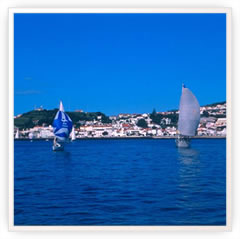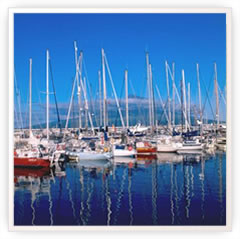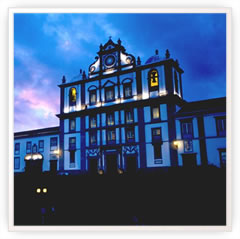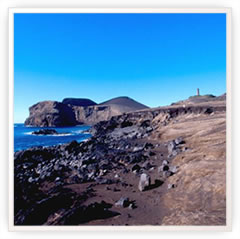Faial Island




HISTORY
Named the Island of Ventura in ancient maps and portolan charts and the Island of S. Luís by the Portuguese sailors who first discovered it, according to legend the first inhabitant was a hermit seeking refuge from the world.
Later, Josse van Huerter, a wealthy Flemish, accompanied by fifteen of his fellow countrymen, found it to be inhabited by settlers from Portugal when he landed there in search of the tin and silver lodes that were said to exist on the island. Initial surveys indicated that a mistake had been made and the expedition was considered a failure. Excited, however, by the fertility of the island, van Hurtere refused to give up.
Through the intercession of the Duchess of Burgundy, a daughter of King Joao I of Portugal, he was appointed Donatory of the island in 1468 and acquired the right to introduce settlers from Flanders, which had been devastated by the Hundred Years' War. They established themselves in the parish of Flamengos, a name which recalls their origins, and later in the Horta area.
The island prospered due to agriculture and the export of woad used in dyeing.
In 1583, as part of the occupation of the Azores which had begun with a landing on the Island of Terceira, a Spanish fleet sailed to Faial. A detachment of armed men landed at Pasteleiro and engaged the defenders, who were reinforced with French troops, in battle, eventually conquering the island. This was followed by attacks by English privateers, which caused large-scale damage, and the devastation of the 1672 volcanic eruption.
In the 19th century Faial played an active role in the struggle between Liberals and Absolutists, eventually supporting the former, and received a visit from King Pedro IV in 1832. In addition to its brave fighters, Faial also supplied the Liberal cause with an arsenal for the fleet that landed at Mindelo. Its Atlantic location and sheltered port continued to attract cargo ships from the orange trade and American whalers, which called there for supplies, until around 1860. During the 20th century Faial was an important centre for underwater cable links and was involved in the pioneer period of aviation.
Today Faial is a developing island, with an economy based on agriculture, livestock, the dairy industry, fishing and trade.
GEOGRAPHY
The Island of Faial, which has an irregular pentagon shape and an area of 173.42 km2, is 21 km long and is 14 km at its widest point. Dominated by the volcanic cone of Caldeira with its gentle slopes interrupted by secondary volcanic formations, the highest point on the island is Cabeço Gordo, which has an altitude of 1,043 m.
GASTRONOMY
Holy Spirit soup
Sausage with yams
"Molha de carne" (a meat dish)
"Morcela" Black pudding
Fried pork fat in wine and garlic
Octopus stewed in wine
Fish stew
"Lapas de Molho Afonso" (Limpets in Afonso sauce)
"Arroz de Lapas" (Limpet risotto)
Cheese
"Fofas" (cakes)
Rice pudding
Corn cake
FESTIVALS
THE HOLY SPIRIT FESTIVAL
This festival is celebrated on all the islands although it varies in detail from one to another and even within different areas of the islands themselves. All the parishes in each island have a chapel, known as an "Império" (empire), with its own brotherhood. These are considered the most typical in the islands'' tradition of religious festivals.
Place: Throughout the archipelago
Date: May to September and in particular the 7th Sunday after Easter
Event õrganisation: The Holy Spirit Brotherhoods
THE FESTIVAL OF S. JOÃO
São João is one of the most revered patron saints and the 24 June is devoted entirely to him. The origin of the festivals dates back to the colonisation of the Island of Terceira by Portuguese nobles. Since S. João is the patron saint of the Portuguese nobility, those who had settled there dedicated a chapel to him to be used in the religious celebrations.
Place: The Islands of Terceira, Flores and Faial
Date: 24 June
Event õrganisation: Festival committee
THE FESTIVAL OF "NOSSA SENHORA DAS ANGÚSTIAS"
This festival takes place every year and is considered the largest religious festival on the Island of Faial. The cult of "Nossa Senhora das Angústias" dates back to the early settlements and the primitive chapel dedicated to Our Lady was commissioned by D. Brites de Macedo. It contains an image of Our Lady that was brought from Flanders.
Place: The parish of Angústias in the municipality of Horta, on the Island of Faial
Date: 6th Sunday after Easter
Event õrganisation: Festival committee
SEA WEEK
Musical groups from the mainland and the other islands, together with orchestras and folk groups from the island perform throughout the week. There are also craft exhibitions, a book fair and various sports events in the Horta Bay, Canal and Porto Pim Beach.
Place: Horta
Date: 1st week in August
Event õrganisation: The "Sea Week" committee
PLACES TO VISIT
THE CAPELINHOS VOLCANO
Following a volcanic eruption in 1957/58 in the parish of Capelo on the extreme west of the Island of Faial, the area of the island was increased by approximately 2.4 km2.
"CALDEIRA"
Volcanic cone dominating the island. The wide, deep crater at its summit, which is 1.450 m in diameter and 400 m deep, is covered in cedars, juniper, beech, ferns and moss, some of which are important examples of the original vegetation of the island.
HORTA MARINA
Officially opened on 3 June 1986, this was the first marina to be built in the Azores. In addition to providing shelter for those crossing the Atlantic by sea, its walls also display an unusual form of decoration, the fruit of the imagination and skills of all who drop anchor there.
